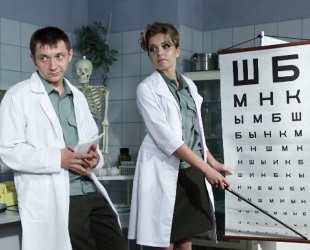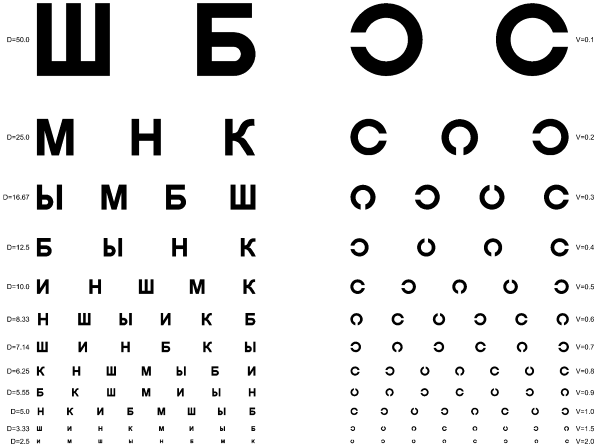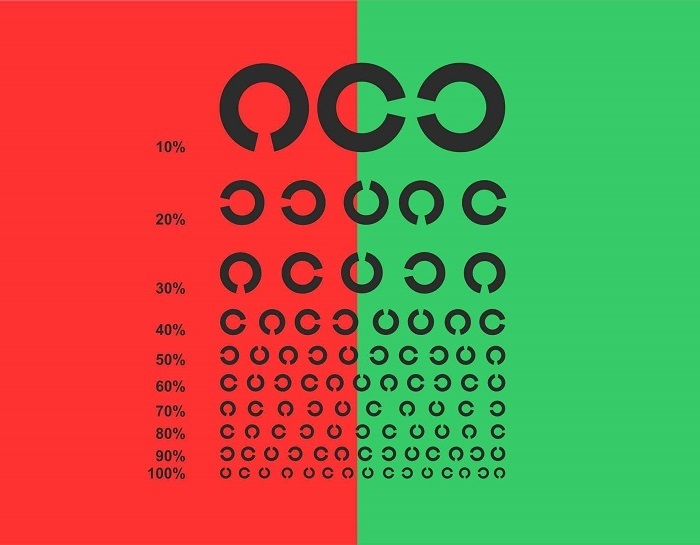
A full-fledged examination of the work of the organs of vision can be made only with an ophthalmologist.
But some preliminary data can be obtained independently at home.
If a person noticed that his eyes began to see worse, then you should immediately check your eyesight.
Preliminary data can be obtained using ophthalmic self-test tests, which will then be adjusted and refined by the physician.
- 1. Possible problems and their causes
- 2. Methods of checking
- 3. Follow-up to
- 4. Results of
- 5. Video of
Possible problems and their causes
Visual impairments can be of the following character:
- Focusing complexityon objects located at close or far distance. It is caused by hyperopia and myopia.
- Blur the picture in the eyes. This problem is caused by astigmatism and often manifests itself with myopia.
- Falling of those or other fields of vision. It can be a symptom of retinal detachment, lesions of blood vessels, injuries, etc.
Vision disorders have two most common causes: genetic predisposition and age-related eye degradation.
The role of human behavior and hygiene is important: with a careless attitude towards one's eyesight, with its constantly overstraining genetic defects will manifest themselves much more strongly and heavier, and old age degradation will make itself felt in 40-50 years.

The general principle of visual acuity is that the light rays entering the retina in the healthy eye converge strictly at one point on the retina, and the brain receives information about a clear image.
With astigmatism, myopia or farsightedness, the rays fall into defocused form, and the nerve signals transmit a fuzzy image to the brain.
The reasons for this may be different: too large a distance between the lens and the retina for myopia, the weakening of the refractive lens of the muscle with farsightedness, the violation of the sphericity of the cornea with astigmatism.
Methods of testing
The Sitzev and Orlova tables
The simplest and most well-known test method is the standard Sittsev table. They have two options: with letters and with c-shaped circles, rotated at different angles.
The second option is used to test vision in children up to 7-8 years old, who have not yet learned to read.
The most important thing to consider when using tables is the correct ratio of their distance to the eyes and the size of the symbols printed on them. This ratio is determined using online programs.
It is enough to specify the distance of the check and the required length of the table, after which the program will display a table with the size of the characters, exactly suitable for the specified parameters.
The table can be printed, but it can be checked directly on the monitor. In the second case, you should not allow the appearance of highlights. The table is printed on white sheets of A4 size.
If the scan distance is too long and the A4 size is not enough to accommodate all the letters, several sheets are printed and fastened together with adhesive tape.
If the child is not interested in looking at images of abstract figures, then you can use the table( Orlova table), which depicts various drawings.
The room should be well lit, to avoid crosses of light sources during the day, curtains should be closed. The test is performed from the tenth line of the table.

One eye needs to be closed, but do not screw up, it's best to cover it with your hand. With a healthy vision, the letters in the tenth line are clearly visible.
If you can not see them, go to higher lines until you get a clear picture of the characters on them. Repeat the procedure with the second eye.

Healthy well see 10( 1.0) line, with minor violations only 8 and 9 rows are visible( 0,8 and 0,9 respectively), poor discrimination of higher strings unequivocally indicates problems with eyesight.
The numbers( 1.0, 0.9, 0.8, and so on) shown to the right of the lines indicate the percentage of visual acuity in relation to the norm.
Do not try to make a clear diagnosis yourself.
This can only be done by an ophthalmologist during a comprehensive check-up using procedures that are not possible for carrying out a home( for example, examining the fundus).
Independent interpretation of the results can only indicate a possible problem and the direction of further diagnostics.
Duohromnyf test
If the test on the Sittseva table has given negative results, then a duochromic test should be performed. It is also necessary to consider the symbols on the table, the difference is that it is divided into halves of red and green colors.
If the symbols are better visible on the green half, then there is a long sight, and a good discrimination of the image on the red half indicates shortsightedness.
In this test, the table is necessarily printed, because the color rendering of the monitor can make serious adjustments to the result. For children there is a version with c-shaped circles instead of letters.
The test for astigmatism is carried out using images in the form of the sun: from the center, on identical intervals, several lines are drawn along the entire circumference.
The thickness of the lines varies so that they can be easily discerned by a healthy person, but astigmatism-stricken eyes would see these lines indistinctly.
The color perception is checked using pictures consisting of many small circles of different colors, among which there is a line of one color that forms a digit. If the figure differs without problems, then there is no problem with color perception.

The Amsler table of the
At home, it is possible to check and rare sight disorders. Macular degeneration( central vision defect) is diagnosed by the Amsler table.

It looks simple: a grid of black lines that forms squares of the same areas, and in the center a black filled circle. To check, one eye closes, and the other looks at the black point for a minute.
With macular degeneration, the lattice will begin to deform, wavy lines, refractions and other distortions will appear on it.
Follow-up Actions
If the results of the tests indicate a violation, contact your ophthalmologist. At the reception, give him the results of self-diagnosis, specify the conditions under which she was conducted.
Immediately take measures to prevent further deterioration of vision: minimize the work behind the computer, eliminate other factors of overvoltage.
But do not engage in self-medication. Their use can prescribe only a doctor after a detailed and comprehensive outpatient diagnosis. It is allowed to use only moisturizing and restorative preparations.
Interesting test
Results of
At home, you can conduct a number of diagnostic measures for the following eye diseases: hyperopia, myopia, astigmatism, color disturbances, macular degeneration.
For this, a set of tests is performed, which consists of examining various tables and images. The required scales and proportions of sizes and distances should be strictly observed.
The results of such diagnostics are approximate and require further clarification during the consultation of the ophthalmologist and out-patient examination
Video
We recommend the following video:
